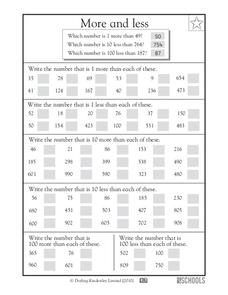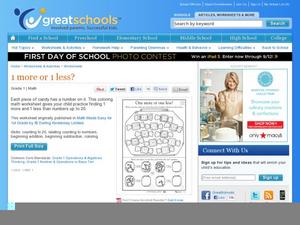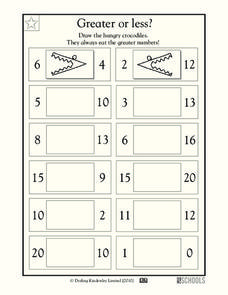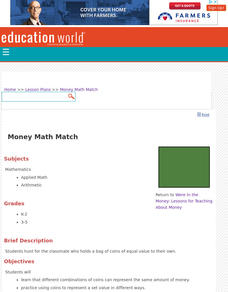DK Publishing
Finding 5 - Multiplying by 5
Visualize multiplication facts using rectangular arrays. Scholars multiply single-digit factors by five and represent each number sentence using sets of dots. They circle the groups of five and fill in missing parts of the equations....
Curated OER
Square Corners
Are these angles greater than, less than, or equal to a square corner? Using a visual guide, young geometers label 16 angles into one of these three categories. Use this before introducing the terms acute, obtuse, and right...
Curated OER
Mean, Median, and Mode
Show scholars the three ways to find an average: mean, median, and mode. They reference a guided example before doing these on their own. There are three sets of data and learners find the three averages for each. All...
DK Publishing
Money Word Problems #2
Are you experiencing money problems? Here are some more! Young mathematicians practice their addition and subtraction skills with money values in these word problems and number sentences. Some of the 25 questions prompt scholars to...
Curated OER
Color the Quilt
In this addition without regrouping worksheet, students will find the sums of 9 addition problems each on a square of a quilt. Then students will color the squares according to a key.
Curated OER
Using Addends and Sum/Using Subtrahend, Minuend, and Difference
What is an addend? What is a sum? Review this math terminology on the top half of the worksheet before practicing basic addition.
Curated OER
More and Less
Mental mathematicians add and subtract 1, 10, and 100 from sets of numbers. Each set of one, two and three-digit numbers gives scholars a chance to practice their addition and subtraction skills. There are 62 whole numbers in all. What...
Curated OER
Subtracting To 10
In this math worksheet, students learn that subtracting means taking one number away from a larger number. Students look at the example and pictures and solve 45 problems.
Curated OER
Counting by 3s, 4s, and 5s
Can learners recognize the pattern in these number sequences? Here's a hint: it's skip counting by either three, four, or five. There are three examples at the top demonstrating each of these, and scholars complete 15 number sequences to...
Curated OER
Hopping by 2s
Hop to it! Young counters practice skip counting by two using illustrations of animals hopping from place to place. Each image shows a number sequence and scholars draw in the path as they move from number to number. Encourage them to...
DK Publishing
Money for Chores - Mixed Tables
Do your young mathematicians get paid for chores at home? Use this familiar real-world concept to explore multiplication and money math. They use a chart of chore payments to answer six questions and determine how much money Joe and...
DK Publishing
Sets
Do scholars understand multiplication as sets of numbers? Help them grasp this concept through groups of objects arranged as a makeshift multiplication number sentence. They examine the sets and fill in boxes to indicate how many sets of...
Curated OER
One More or One Less?
Hook new mathematicians with a candy-themed approach to addition and subtraction. They examine 10 numbers (not exceeding 19) printed on candy wrappers. For each, learners calculate and record numbers with values one more and one...
Curated OER
Match the Times
Get youngsters comfortable with telling time on both analog and digital clocks. They match times to the clock faces, all of which read a time on the hour or half-hour. The times are written out here (i.e. "half past nine" or "9...
Curated OER
Sorting 2-Dimensional Shapes
Some shapes have square corners, and some do not. Scholars participate in a sorting activity as they determine if these 12 shapes have square corners, categorizing them based on this attribute. Encourage geometers to draw the square into...
Curated OER
Greater or Less?
These crocodiles are hungry for the biggest numbers they can find! This is a fun way to illustrate number comparison; use crocodile mouths as the greater than and less than symbols. There are two examples (with teeth...
Curated OER
Frisbee Baseball
Students keep track of the number of tosses it takes them to reach each base, and encourage team members and recognize their successes. To make this activity fit the level of older classes, measure distances and figure averages as you play!
Curated OER
Money Math Match
Students hunt for the classmate who holds a bag of coins equal in value to theirs, study that different combinations of coins can represent the same amount of money and practice using coins to represent a set value in different ways.
Curated OER
Practice Using a Ruler
In this using a ruler worksheet, students utilize a ruler to measure the length of four objects and then choose four small objects from their desk to outline and measure.
DK Publishing
It's Raining Numbers! - Mixed Tables
It's raining math problems! Use this multiplication and division skills practice on a rainy day as scholars fill in water drops to complete number sentences. They fill in products, factors, dividends, divisors, and quotients to solve...
Curated OER
Tables and Graphs
Help pupils read graphs and tables with these examples and data comprehension questions. First they examine a bar graph to answer five analysis prompts. Note this graph doesn't have a label along the y-axis, so you may want to do this...
Curated OER
Lift the Math Curse
Students complete a variety of activities related to the book "Math Curse" by Jon Scieszka. They write a story about a day in their life that includes illustrations, fifteen math problems, the written story, and an answer key. Students...
Curated OER
Days and Seasons
Introduce young scholars to calendars as they practice the days of the week and four seasons. First graders complete three days-of-the-week sequences, each starting on a different day. They can reference the completed sequence example...
Curated OER
Counting Forward or Back
What comes next? Young counters follow the stone path to each house, filling in numbers in a sequence as they go. Some of these move forward and some backward, but all progress by ones. Learners start with given numbers and then follow...























